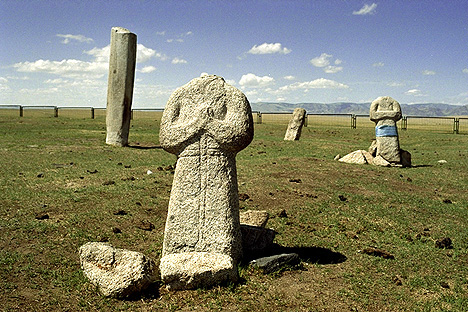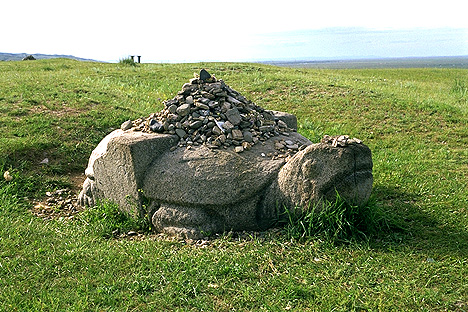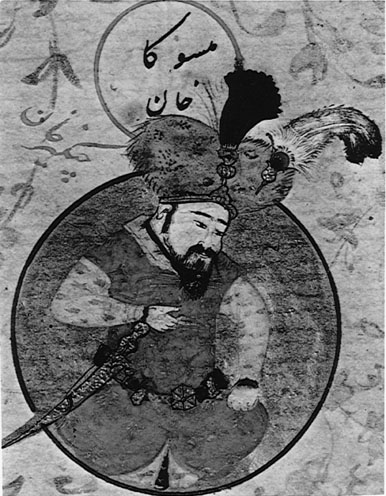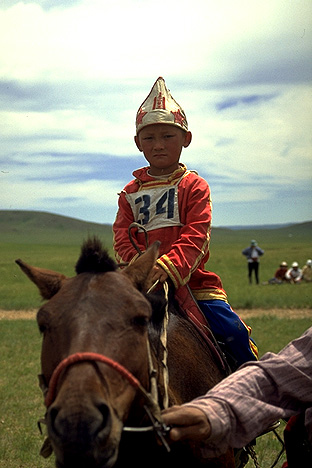
Early Development, ca. 220 B.C.-A.D. 1206
Origins of the Mongols
Archaeological evidence places early Stone Age human habitation in the southern Gobi between 100,000 and 200,000 years ago. By the first millennium B.C., bronze-working peoples lived in Mongolia. With the appearance of iron weapons by the third century B.C., the inhabitants of Mongolia had begun to form tribal alliances and to threaten China. The origins of more modern inhabitants are found among the forest hunters and nomadic tribes of Inner Asia. They inhabited a great arc of land extending generally from the Korean Peninsula in the east, across the northern tier of China to the Kazakh Soviet Socialist Republic and to the Pamir Mountains and Lake Balkash in the west. During most of recorded history, this has been an area of constant ferment from which emerged numerous migrations and invasions to the southeast (into China), to the southwest (into Transoxiana--modern Uzbek Soviet Socialist Republic, Iran, and India), and to the west (across Scythia toward Europe). By the eighth century B.C., the inhabitants of much of this region evidently were nomadic Indo-European speakers, either Scythians or their kin. Also scattered throughout the area were many other tribes that were primarily Mongol in their ethnologic characteristics.
Xiongnu and Yuezhi
The first significant recorded appearance of nomads came late in the third century B.C., when the Chinese repelled an invasion of the Xiongnu (Hsiung-nu in Wade-Giles romanization) across the Huang He (Yellow River) from the Gobi. The Xiongnu were a nomadic people of uncertain origins. Their language is not known to modern scholars, but the people were probably similar in appearance and characteristics to the later Mongols. A Chinese army, which had adopted Xiongnu military technology--wearing trousers and using mounted archers with stirrups--pursued the Xiongnu across the Gobi in a ruthless punitive expedition. Fortification walls built by various Chinese warring states were connected to make a 2,300-kilometer Great Wall along the northern border, as a barrier to further nomadic inroads.
The Xiongnu temporarily abandoned their interest in China and turned their attention westward to the region of the Altai Mountains and Lake Balkash, inhabited by the Yuezhi (Yeh-chih in Wade-Giles), an Indo-European-speaking nomadic people who had relocated from China's present-day Gansu Province as a result of their earlier defeat by the Xiongnu. Endemic warfare between these two nomadic peoples reached a climax in the latter part of the third century and the early decades of the second century B.C.; the Xiongnu were triumphant. The Yuezhi then migrated to the southwest where, early in the second century, they began to appear in the Oxus (the modern Amu Darya) Valley, to change the course of history in Bactria, Iran, and eventually India.
Meanwhile, the Xiongnu again raided northern China about 200 B.C., finding that the inadequately defended Great Wall was not a serious obstacle. By the middle of the second century B.C., they controlled all of northern and western China north of the Huang He. This renewed threat led the Chinese to improve their defenses in the north, while building up and improving the army, particularly the cavalry, and while preparing long-range plans for an invasion of Mongolia.
Between 130 and 121 B.C., Chinese armies drove the Xiongnu back across the Great Wall, weakened their hold on Gansu Province as well as on what is now Nei Monggol Autonomous Region, and finally pushed them north of the Gobi into central Mongolia. Following these victories, the Chinese expanded into the areas later known as Manchuria, the Korean Peninsula, and Inner Asia. The Xiongnu, once more turning their attention to the west and the southwest, raided deep into the Oxus Valley between 73 and 44 B.C. The descendants of the Yuezhi and their Chinese rulers, however, formed a common front against the Xiongnu and repelled them.
During the next century, as Chinese strength waned, border warfare between the Chinese and the Xiongnu was almost incessant. Gradually the nomads forced their way back into Gansu and the northern part of what is now China's Xinjiang-Uygur Autonomous Region. In about the middle of the first century A.D., a revitalized Eastern Han Dynasty (A.D. 25-220) slowly recovered these territories, driving the Xiongnu back into the Altai Mountains and the steppes north of the Gobi. During the late first century A.D., having reestablished the administrative control over southern China and northern Vietnam that had been lost briefly at beginning of this same century, the Eastern Han made a concerted effort to reassert dominance over Inner Asia. A Chinese army crossed the Pamir Mountains, conquered territories as far west as the Caspian Sea, defeated the Yuezhi Kushan Empire, and even sent an emissary in search of the eastern provinces of Rome.
Donghu, Toba, and Ruruan
Although the Xiongnu finally had been driven back into their homeland by the Chinese in A.D. 48, within ten years the Xianbei (or Hsien-pei in Wade-Giles) had moved (apparently from the north or northwest) into the region vacated by the Xiongnu. The Xianbei were the northern branch of the Donghu (or Tung Hu, the Eastern Hu), a proto-Tunguz group mentioned in Chinese histories as existing as early as the fourth century B.C. The language of the Donghu, like that of the Xiongnu, is unknown to modern scholars. The Donghu were among the first peoples conquered by the Xiongnu. Once the Xiongnu state weakened, however, the Donghu rebelled. By the first century, two major subdivisions of the Donghu had developed: the Xianbei in the north and the Wuhuan in the south. The Xianbei, who by the second century A.D. were attacking Chinese farms south of the Great Wall, established an empire, which, although short-lived, gave rise to numerous tribal states along the Chinese frontier. Among these states was that of the Toba (T'o-pa in Wade-Giles), a subgroup of the Xianbei, in modern China's Shanxi Province. The Wuhuan also were prominent in the second century, but they disappeared thereafter; possibly they were absorbed in the Xianbei western expansion. The Xianbei and the Wuhuan used mounted archers in warfare, and they had only temporary war leaders instead of hereditary chiefs. Agriculture, rather than full-scale nomadism, was the basis of their economy. In the sixth century A.D., the Wuhuan were driven out of Inner Asia into the Russian steppe.
Chinese control of parts of Inner Asia did not last beyond the opening years of the second century, and, as the Eastern Han Dynasty ended early in the third century A.D., suzerainty was limited primarily to the Gansu corridor. The Xianbei were able to make forays into a China beset with internal unrest and political disintegration. By 317 all of China north of the Chang Jiang (Yangtze River) had been overrun by nomadic peoples: the Xianbei from the north; some remnants of the Xiongnu from the northwest; and the Chiang people of Gansu and Tibet (present-day China's Xizang Autonomous Region) from the west and the southwest. Chaos prevailed as these groups warred with each other and repulsed the vain efforts of the fragmented Chinese kingdoms south of the Chang Jiang to reconquer the region.
By the end of the fourth century, the region between the Chang Jiang and the Gobi, including much of modern Xinjiang, was dominated by the Toba. Emerging as the partially sinicized state of Dai between A.D. 338 and 376 in the Shanxi area, the Toba established control over the region as the Northern Wei Dynasty (A.D. 386-533). Northern Wei armies drove back the Ruruan (referred to as Ruanruan or Juan-Juan by Chinese chroniclers), a newly arising nomadic Mongol people in the steppes north of the Altai Mountains, and reconstructed the Great Wall. During the fourth century also, the Huns left the steppes north of the Aral Sea to invade Europe. By the middle of the fifth century, Northern Wei had penetrated into the Tarim Basin in Inner Asia, as had the Chinese in the second century. As the empire grew, however, Toba tribal customs were supplanted by those of the Chinese, an evolution not accepted by all Toba.
The Ruruan, only temporarily repelled by Northern Wei, had driven the Xiongnu toward the Ural Mountains and the Caspian Sea and were making raids into China. In the late fifth century, the Ruruan established a powerful nomadic empire spreading generally north of Northern Wei. It was probably the Ruruan who first used the title khan.
|  |
Rise of the Tureg
Northern Wei was disintegrating rapidly because of revolts of semi-tribal Toba military forces that were opposed to being sinicized, when disaster struck the flourishing Ruruan Empire. The Trk, a vassal people, known as Tujue to Chinese chroniclers, revolted against their Ruruan rulers. The uprising began in the AltaCommand.

Influence of Tang China
From 629 to 648, a reunited China--under the Tang Dynasty (A.D. 618-906)--destroyed the power of the Eastern Trk north of the Gobi; established suzerainty over the Kitan, a semi-nomadic Mongol people who lived in areas that became the modern Chinese provinces of Heilongjiang and Jilin; and formed an alliance with the Uighurs, who inhabited the region between the Altai Mountains and Lake Balkash. Between 641 and 648, the Tang conquered the Western Trk, reestablishing Chinese sovereignty over Xinjiang and exacting tribute from west of the Pamir Mountains. The Trk empire finally ended in 744.
For more than a century, the Tang retained control of central and eastern Mongolia and parts of Inner Asia. During this century, the Tang expanded Chinese control into the Oxus Valley. At the same time, their allies and nominal vassals, the Uighurs, conquered much of western and northern Mongolia until, by the middle of the eighth century, the Uighur seminomadic empire extended from Lake Balkash to Lake Baykal.
It was at about this time that the Arab-led tide of Islam reached Inner Asia. After a bitter struggle, the Chinese were ejected from the Oxus Valley, but with Uighur assistance they defeated Muslim efforts to penetrate into Xinjiang. The earliest Mongol links with Tibetan Buddhism, or Lamaism, also may have been established in this period. During this time, the Kitan of western Manchuria took advantage of the situation to throw off Chinese control, and they began to raid northern China.
Despite these crippling losses, the Tang recovered and, with considerable Uighur assistance, held their frontiers. Tang dependence upon their northern allies was apparently a source of embarrassment to the Chinese, who surreptitiously encouraged the Kirghiz and the Karluks to attack the Uighurs, driving them south into the Tarim Basin. As a result of the Kirghiz action, the Uighur empire collapsed in 846. Some of the Uighurs emigrated to Chinese Turkestan (the Turpan region), where they established a flourishing kingdom that freely submitted to Chinggis Khan several centuries later. Ironically, this weakening of the Uighurs undoubtedly hastened the decline and fall of the Tang Dynasty over the next fifty years.

Mongolia
Kitan and Jurchen
Free of Uighur restraint, the Kitan expanded in all directions in the latter half of the ninth century and the early years of the tenth century. By 925 the Kitan ruled eastern Mongolia, most of Manchuria, and much of China north of the Huang He. In the recurrent process of sinicization, by the middle of the tenth century Kitan chieftains had established themselves as emperors of northern China; their rule was known as the Liao Dynasty (916-1125).
The period of the eleventh and twelfth centuries was one of consolidation, preceding the most momentous era in Mongol history, the era of Chinggis Khan. During those centuries, the vast region of deserts, mountains, and grazing land was inhabited by people resembling each other in racial, cultural, and linguistic characteristics; ethnologically they were essentially Mongol. The similarites among the Mongols, Trk, Tangut, and Tatars who inhabited this region causes considerable ethnic and historical confusion. Generally, the Mongols and the closely related Tatars inhabited the northern and the eastern areas; the Trk (who already had begun to spread over western Asia and southeastern Europe) were in the west and the southwest; the Tangut, who were more closely related to the Tibetans than were the other nomads and who were not a Turkic people, were in eastern Xinjiang, Gansu, and western Inner Mongolia. The Liao state was homogeneous, and the Kitan had begun to lose their nomadic characteristics. The Kitan built cities and exerted dominion over their agricultural subjects as a means of consolidating their empire. To the west and the northwest of Liao were many other Mongol tribes, linked together in various tenuous alliances and groupings, but with little national cohesiveness. In Gansu and eastern Xinjiang, the Tangut--who had taken advantage of the Tang decline--had formed a state, Western Xia or Xixia (1038-1227), nominally under Chinese suzerainty. Xinjiang was dominated by the Uighurs, who were loosely allied with the Chinese.
The people of Mongolia at this time were predominantly spirit worshipers, with shamans providing spiritual and religious guidance to the people and tribal leaders. There had been some infusion of Buddhism, which had spread from Xinjiang, but it did not yet have a strong influence. Nestorian Christianity also had penetrated Inner Asia.
In the eleventh century, the Kitan completed the conquest of China north of the Huang He. Despite close cultural ties between the Kitan and Western Xia that led the latter to become increasingly sinicized, during the remainder of that century and the early years of the twelfth century, the two Mongol groups were frequently at war with each other and with the Song Dynasty (A.D. 960-1279) of China. The Uighurs of the Turpan region often were involved in these wars, usually aiding the Chinese against Western Xia.
A Tungusic people, the Jurchen, ancestors of the Manchu, formed an alliance with the Song and reduced the Kitan Empire to vassal status in a seven-year war. The Jurchen leader proclaimed himself the founder of a new era, the Jin Dynasty (1115-1234). Scarcely pausing in their conquests, the Jurchen subdued neighboring Koryo (Korea) in 1226 and invaded the territory of their former allies, the Song, to precipitate a series of wars with China that continued through the remainder of the century. Meanwhile, the defeated Kitan Liao ruler had fled with the small remnant of his army to the Tarim Basin, where he allied himself with the Uighurs and established the Karakitai state (known also as the Western Liao Dynasty, 1124-1234), which soon controlled both sides of the Pamir Mountains. The Jurchen turned their attention to the Mongols who, in 1139 and in 1147, warded them off.

|
|  |
|